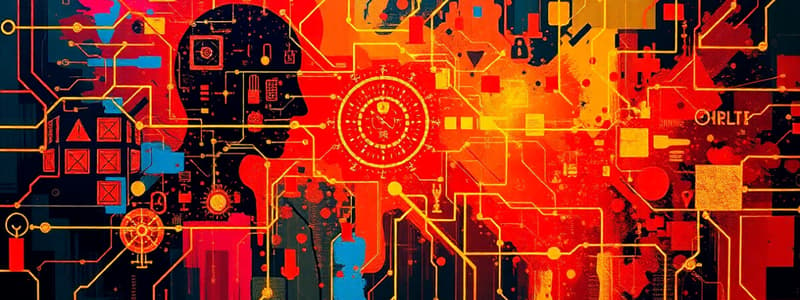Podcast
Questions and Answers
What does information security primarily focus on?
What does information security primarily focus on?
- Implementing financial controls to safeguard organizational assets
- Protecting information and information systems from unauthorized actions (correct)
- Managing physical security measures for facilities
- Conducting training sessions for employees on technology use
Which factor contributes to the increasing vulnerability of organizational information resources?
Which factor contributes to the increasing vulnerability of organizational information resources?
- The adoption of only static networking infrastructure
- Outdated data storage devices being used
- The increasing capabilities of wireless technologies (correct)
- Limited access to the internet for employees
How has hacking skill accessibility changed in recent years?
How has hacking skill accessibility changed in recent years?
- Hacking is now restricted to only a few expert individuals
- The skills required remain unchanged since the past decade
- The skill requirements have decreased due to available scripts online (correct)
- The skills needed have become more complex and advanced
What is a notable characteristic of modern computer and storage devices?
What is a notable characteristic of modern computer and storage devices?
What has contributed to the rise of cybercrime among organized groups?
What has contributed to the rise of cybercrime among organized groups?
Which group of employees is considered to pose the greatest threat to information security?
Which group of employees is considered to pose the greatest threat to information security?
What is social engineering primarily concerned with?
What is social engineering primarily concerned with?
Which of the following is NOT considered an unintentional threat to information systems?
Which of the following is NOT considered an unintentional threat to information systems?
What does 'ransomware-as-a-service' refer to?
What does 'ransomware-as-a-service' refer to?
Which of these methods is effective for protecting against ransomware?
Which of these methods is effective for protecting against ransomware?
Which situation exemplifies 'tailgating' in the context of security threats?
Which situation exemplifies 'tailgating' in the context of security threats?
What is a consequence of ransomware attacks aside from direct ransom payments?
What is a consequence of ransomware attacks aside from direct ransom payments?
What is the primary goal of risk management in an organization?
What is the primary goal of risk management in an organization?
Which of the following is NOT a form of intellectual property protection?
Which of the following is NOT a form of intellectual property protection?
Which term describes the unlawful assumption of another person’s identity?
Which term describes the unlawful assumption of another person’s identity?
What is a common consequence of identity theft?
What is a common consequence of identity theft?
What type of software is designed to collect personal information without consent?
What type of software is designed to collect personal information without consent?
Which threat demonstrates the potential for physical harm or disruption through computer systems?
Which threat demonstrates the potential for physical harm or disruption through computer systems?
Which of the following components is NOT involved in a standard SCADA system?
Which of the following components is NOT involved in a standard SCADA system?
Which of the following best describes the function of keystroke loggers?
Which of the following best describes the function of keystroke loggers?
What is the primary role of risk mitigation in risk management?
What is the primary role of risk mitigation in risk management?
What is the primary purpose of risk transference in risk management?
What is the primary purpose of risk transference in risk management?
Which of the following best describes the role of an information systems auditor?
Which of the following best describes the role of an information systems auditor?
What are COBIT 5 key principles designed to ensure?
What are COBIT 5 key principles designed to ensure?
Which of the following controls is categorized as a general control?
Which of the following controls is categorized as a general control?
What distinguishes a hot site from a cold site in business continuity planning?
What distinguishes a hot site from a cold site in business continuity planning?
What is the main function of access controls in information security?
What is the main function of access controls in information security?
What does the term 'risk limitation' refer to?
What does the term 'risk limitation' refer to?
Which of the following is a key component of business continuity planning?
Which of the following is a key component of business continuity planning?
Which physical control is NOT commonly used to secure a company's facilities?
Which physical control is NOT commonly used to secure a company's facilities?
Flashcards
Information Security
Information Security
Processes and policies protecting organizational information and systems from unauthorized access, use, disclosure, disruption, modification, or destruction.
Threat to an Information Resource
Threat to an Information Resource
Any danger to which a system may be exposed, potentially causing harm or loss.
Information Resource's Vulnerability
Information Resource's Vulnerability
The possibility that a threat will harm a resource.
Increasing Vulnerability Factors
Increasing Vulnerability Factors
Signup and view all the flashcards
Cybercrime
Cybercrime
Signup and view all the flashcards
Unintentional Threats
Unintentional Threats
Signup and view all the flashcards
Human Error (Threat)
Human Error (Threat)
Signup and view all the flashcards
Social Engineering
Social Engineering
Signup and view all the flashcards
Tailgating
Tailgating
Signup and view all the flashcards
Ransomware
Ransomware
Signup and view all the flashcards
Spear Phishing
Spear Phishing
Signup and view all the flashcards
Information Extortion
Information Extortion
Signup and view all the flashcards
Identity theft
Identity theft
Signup and view all the flashcards
Intellectual Property
Intellectual Property
Signup and view all the flashcards
Software Attacks
Software Attacks
Signup and view all the flashcards
SCADA Systems
SCADA Systems
Signup and view all the flashcards
Cyberterrorism
Cyberterrorism
Signup and view all the flashcards
Risk Management
Risk Management
Signup and view all the flashcards
Risk Mitigation
Risk Mitigation
Signup and view all the flashcards
Risk Acceptance
Risk Acceptance
Signup and view all the flashcards
Dumpster Diving
Dumpster Diving
Signup and view all the flashcards
Risk transference
Risk transference
Signup and view all the flashcards
Information Systems Audit
Information Systems Audit
Signup and view all the flashcards
General Controls
General Controls
Signup and view all the flashcards
Application Controls
Application Controls
Signup and view all the flashcards
Hot Site
Hot Site
Signup and view all the flashcards
Authentication
Authentication
Signup and view all the flashcards
Authorization
Authorization
Signup and view all the flashcards
Business Continuity Planning
Business Continuity Planning
Signup and view all the flashcards
Study Notes
Introduction to Information Security
- Security is protection against loss, damage, or danger.
- Information security protects organizational data and systems from unauthorized actions.
- Information resources are exposed to various threats, vulnerabilities, and potential harm.
Increasing Vulnerability Factors
- Evolving IT Environment: Modern IT is complex, interconnected, and reliant on wireless networks, increasing exposure to external threats. Trusted networks are internal; untrusted are external. Wireless is vulnerable to interception.
- Advancements in Devices: Smaller, faster, cheaper, and more portable devices pose an easier target for theft, containing sensitive data.
- Decreasing Hacking Skills: Internet resources make hacking easier, enabling individuals with limited skills to attack systems.
- Rise of Organized Cybercrime: International organized crime groups increasingly involved in non-violent, lucrative cybercrime.
- Lack of Management Support: Senior management must prioritize security policies for organizational-wide adoption.
Unintentional Threats
- Unintentional threats are performed without malicious intent, but still pose a risk to information security.
- Human Error: A major unintentional threat, encompassing laziness, carelessness, and lack of security awareness. Employees at higher levels have greater access risk. Human Resources and Information Systems employees pose the greatest threat due to access to sensitive data. Contract workers and consultants also require consideration. Janitors and security guards also pose a threat due to their access and presence during off-hours, while not always accounted for in security plans.
- Social Engineering: Manipulating employees into revealing confidential information (passwords). Techniques include impersonation, tailgating (following employees into restricted areas), and shoulder surfing (observing screens).
Deliberate Threats
- Deliberate threats involve malicious intent.
- Espionage/Trespass: Unauthorized access attempts.
- Information Extortion: Threatening to steal or stealing information, demanding payment for avoiding harm, known as ransomware or digital extortion.
- Methods of Attack: Spear phishing, whaling, ransomware;
- Costs: Direct-ransom payment, indirect-file recovery costs, reputational damage, lawsuits.
- Protection: User education, regular data backups, anti-ransomware software, the No More Ransom initiative, decryption tools.
- Sabotage/Vandalism: Deliberate acts such as defacing websites.
- Theft of Equipment/Information: Stealing devices containing sensitive data, like laptops, smartphones, and thumb drives. Dumpster diving is a technique involving searching through trash for discarded information.
- Identity Theft: Stealing another person's identity to gain access to financial information or implicating them in a crime.
- Intellectual Property: The unauthorized use of intellectual property, including trade secrets, patents, and copyrights. Trade secrets are confidential information, patents are inventions, and copyrights are creative works.
- Software Attacks: Malicious software targeting systems, including malware and evolving web-based attacks. Malware can target all connected devices like smart TVs.
- Alien Software: Clandestine software installations (not as damaging as viruses or worms). Examples include adware, spyware (including stalkerware for monitoring people), keyloggers, and spamware.
- Supervisory Control and Data Acquisition (SCADA) Attacks: Targeting industrial control systems, such as oil refineries, water treatment plants, and nuclear power plants. SCADA systems link physical operations with electronic control mechanisms, making access points vulnerable.
- Cyberterrorism/Cyberwarfare: Attackers using computer systems for physical harm or disruption to promote a political agenda.
Protecting Information Resources
- Risk Management: Identifying, controlling, minimizing the impact of threats, reducing risks to acceptable levels.
- Risk Evaluation: Analyzing assets, their vulnerability to compromise, and costs of protection.
- Risk Mitigation Strategies: Risk acceptance, transference (insurance), and limitation (controls) are three approaches.
- Information Systems Auditing: Evaluation and examination of information system controls and processes using established standards.
- Types of Auditors: External, internal, government, specialist.
- COBIT 5: IT governance framework aligning IT with business needs, and managing risk. This involves five key principles to ensure stakeholder needs, an enterprise-wide approach, a single framework, holistic strategies, and separation of governance and management.
Information Security Controls
- Control Environment: Management’s attitude towards controls.
- General Controls: Apply to more than one functional area. Example, password management.
- Application Controls: Specific to an application, such as payroll approval.
- Physical Controls: Prevent unauthorized access to facilities (e.g., walls, locks).
- Business Continuity Planning: Prepare for disaster recovery, offering guidelines for responding to and recovering from disruptions affecting information security. This includes multiple-site and off-site data backups. Hot sites provide complete operations, warm sites offer operations without application software, while cold sites offer the basic utilities like electricity and building systems but do not provide IT operations.
- Access Controls: Restricting unauthorized use of information resources. Access Control has authentication and authorization.
- Authentication: Verifying user identity using various methods: something the user is (biometrics), has (ID card, token), does (voice, signature), or knows (passwords).
- Password Managers: Generate and store complex passwords.
- Multifactor Authentication (MFA): Combining multiple verification factors.
- Passwordless Authentication: Password-free methods.
- Adaptive Authentication: Authentication based on real-time risk assessments.
- Authorization: Establishing rights and privileges based on verified identity. Least privilege is a common principle.
- Communication Controls: Secure data transmission across networks.
- Firewalls: Prevent unauthorized network traffic.
- Anti-malware Systems: Detect and remove viruses and worms.
- Whitelisting/Blacklisting: Controlling which software can run.
- Encryption: Secure data transmission using public-key encryption and digital certificates.
- Virtual Private Networks (VPNs): Securely extending networks over public networks.
- Transport Layer Security (TLS): Secure communication protocol for online transactions (HTTPS).
- Application Controls: Security protection specific to applications (input, processing, and output controls).
Personal Information Asset Protection
- Protecting personal data is crucial when not connected to an organization's network.
- Inventorying/assessing sensitivity of data is the first step towards securing them.
Studying That Suits You
Use AI to generate personalized quizzes and flashcards to suit your learning preferences.



